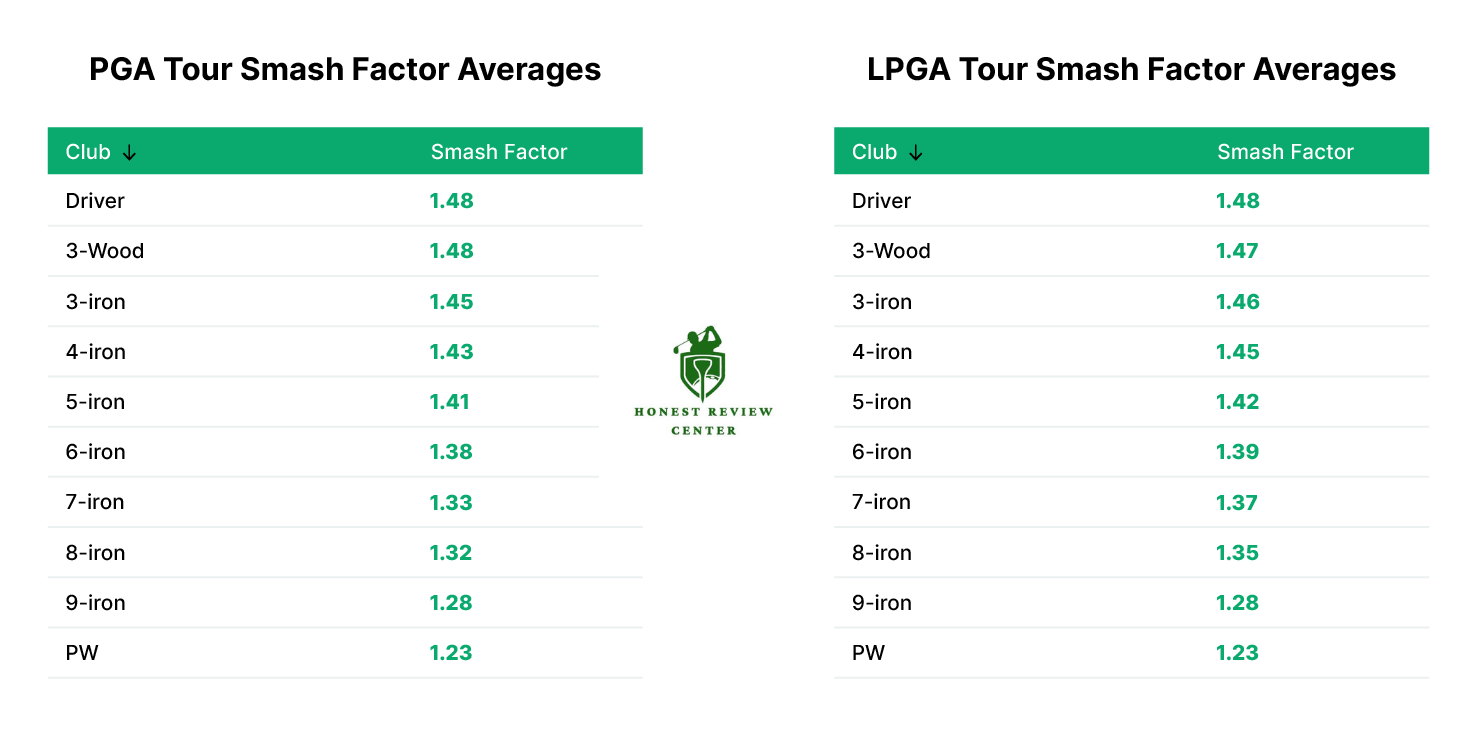Smash Factor on Launch Monitor Full Concept Explained

Golfers are constantly seeking for methods to enhance their game. One key indicator that has gained popularity in recent years is the ‘smash factor’. But what precisely is smash factor and how does it benefit golfers?
Modern launch monitors, which track comprehensive shot data, produce a parameter known as the smash factor. It compares the speed of the clubhead just before and after it collides with the ball.
The smash factor is computed by dividing the post-collision ball speed by the pre-collision club head speed. For example, if your driver clubhead is traveling at 100 mph just before impact and the ball exits the face at 150 mph, your smash factor is 1.5 (150/100 = 1.5).
A larger smash factor implies that more energy is transferred from the club to the ball during impact, resulting in quicker ball speeds and longer distance. The maximum smash factor is around 1.5, which means that the ball leaves the clubface at 1.5 times the speed of the clubhead before to impact. This higher limit is set by factors such as the trampoline effect of the clubface and energy losses.
Smash factors for well-hit shots by experienced golfers utilizing correctly fitted equipment typically vary from 1.4 to 1.5. The smash factor is influenced by factors such as hit location on the clubface, angle of attack, and clubhead speed. Mishits and poor launch angles result in decreased smash factors.
Understanding your personal smash factor might help you pinpoint areas for growth. Low smash factors on a consistent basis may suggest problems with the striking, launch angle, old/ill-fitted equipment, or insufficient clubhead speed. Comparing smash factor figures from different clubs can also highlight your swing’s strengths and shortcomings.
While smash factor has limits and is only one component of launch monitor data, tracking it over time provides useful input. Trying alternative equipment, adjusting launch conditions, and improving striking can all help you maximize smash factor and gain extra distance when you need it.
PGA and LPGA Tour Smash Factor Data

To summarize, smash factor is an important metric offered by current launch monitors. It compares clubhead speed before impact and ball speed after impact. A higher smash factor means better energy transfer and longer shots.
Paying attention to the smash factor can help golfers improve their impact circumstances and equipment. For the majority of players, smash factors between 1.4 and 1.5 are optimal. Making simple changes to increase the smash factor might add yards to drives and result in lower scores.
Frequently Asked Questions: Smash Factor on Launch Monitor
Most golf professionals advocate aiming for a smash factor between 1.4 and 1.5. This shows that you are transferring the maximum amount of energy from your clubhead to the ball during impact. The theoretical maximum smash factor is 1.5, which means that the ball leaves the clubface at 1.5 times the speed of the clubhead just before impact.
For most amateur golfers utilizing properly suited equipment, a smash factor of 1.4-1.5 is ideal. A smash factor of less than 1.4 on a consistent basis can suggest problems with your striking, attack angle, aging clubs, or swing speed, all of which can be costing you distance.
Smash factor and ball speed are similar, however they represent slightly distinct things. Ball speed simply measures the ball’s velocity immediately after impact. The smash factor compares the ball speed after impact to the clubhead speed before impact.
So think of it as how effectively you translate clubhead speed to ball speed. Two golfers may have identical ball speeds, but one has a higher smash factor, indicating that they are making better use of their swing speed. Paying attention to both measures provides more information about your impact efficiency and places for improvement.
There are numerous techniques to optimize the smash factor. First, ensure that your equipment is properly fitted, including club length, loft, shaft flex, and lie angle. Improperly fitting clubs are a common smash factor killer. Second, practice consistent ball-first contact. Fat and thin shots will result in lesser smash factors.
To assess your strike pattern, use an impact spray or foot powder. Third, monitor your attack angle and adjust your driver launch conditions. Steep angles of attack, in particular, can diminish the smash factor.
Fourth, improve clubhead speed with strength training and club fitting. Faster swing rates allow you to fully benefit from the trampoline effect of newer clubfaces. Fifth, consider taking courses to improve your impact technique and gear optimization. An teacher can assist you in adjusting your swing path, angle of attack, and strike to enhance the smash factor.
The smash factor varies between the clubs in your bag. Drivers often have the highest smash factor because to their low loft and huge clubhead size. As lofts climb, smash factors for fairway woods and long irons decrease. This is because higher lofted clubs naturally impart more backspin, resulting in slower ball speed.
The smash factor also decreases for mishits, which are more likely with smaller irons and fairway woods. Differing shaft behavior throughout the swing can also affect smash factor consistency between clubs. Monitoring the smash factor by club might help uncover equipment concerns or areas for improvement in your swing at various lengths.
